5 Hot Hardware Products At DEMO 2009
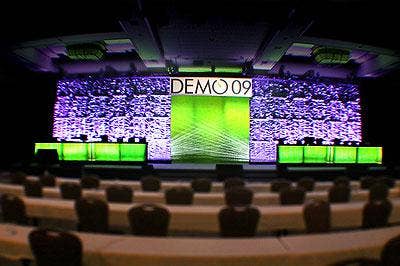
DEMO, the twice-yearly conference which gives companies their six minutes under the spotlight to talk about new products or services, is much better known for demonstrations of social networking software and services than it is for hardware.
Nonetheless, a select few new hardware technologies presented unique opportunities and business models for the Web 2.0 set.
Channelweb.com visited five hardware-oriented demonstrations. Check them out.
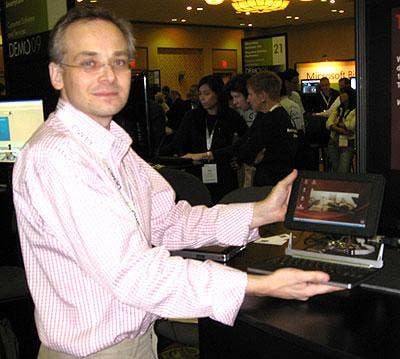
Always Innovating showed a new portable PC that's a cross between a netbook and a tablet PC.
The company's Touch Book weighs only 2 pounds, and opens and closes like a typical netbook PC. However, the screen easily pulls off the keyboard unit to become a portable tablet PC with a touch screen.
Gregoire Gentil, (left), CEO and founder of the Menlo Park, Calif.-based company, said the Touch Book does anything a netbook can do, but uses the ARM processor because of its low heat generation and a battery life of between 10 and 15 hours.
The Touch Book comes configured with the company's own version of Linux, which offers such features as true instant-on. However, Gentil said it can also work with any operating system.
The screen can be detached and used in a standalone mode because the processor, memory and storage are built into the screen. Users can pop the cover of the screen off to plug in USB memory or Wi-Fi or other devices. The screen unit weighs about 1 pound.
Eventually, the screen unit is slated to have a magnetic backing to allow it to sit on metal surfaces and act like a digital display.
The Touch Book is expected to start shipping in June or July with a price starting at $299. The company will initially sell the device direct.
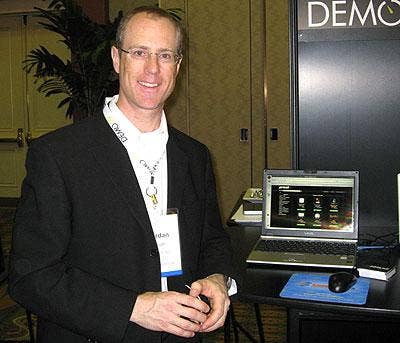
Xandros wants PCs to boot faster and offer a flexible choice of operating environments, and it demonstrated its version of a Linux utility that does just that.
The Ottawa, Ontario-based software developer showed its Presto utility which, when downloaded into any mobile PC, allows the user to boot the PC up in Linux or Windows.
In Windows, the PC takes the industry average of about two minutes to boot up. However, when booting in Presto, the PC is ready for use, including wireless, in about eight seconds.
Presto is a highly stripped-down version of Linux, but it runs typical open-source applications such as the Firefox browser, Skype, RealPlayer and Open Office, said Jordon Smith, (left), product marketing manager.
Because Presto installs as a folder on the Windows disk, users still have access to all their files, Smith said.
Turning off the PC is as simple as pressing a button and closing the LCD screen, he said.
The utility can be used with any portable PC, even older units that may have been sitting in a closet but which could now be repurposed, Smith said.
"There are lots of applications out there," he said. "For instance, you could turn an old computer into a digital photo frame."
The Presto utility is currently in beta and is expected to be available in its final version shortly, Smith said. When finalized, it can be downloaded for $19.95. A free version, supported by advertising, is also possible, he said.
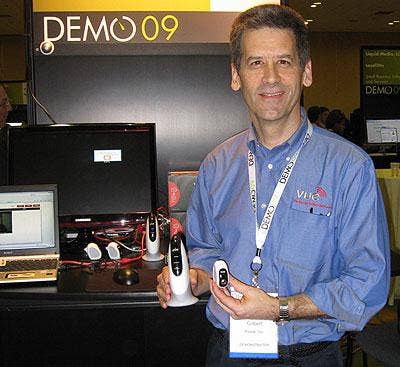
The Vue personal video network from San Diego-based Avaak is a new way to get wireless video quickly into wherever it is needed or wanted.
Vue consists of two battery-powered wireless video cameras, four small camera mounts with self-adhesive backs, a wireless gateway and 12 months of Internet service.
To use, just stick a mount on a wall, snap in a camera, and turn on the camera and gateway. No software is needed. The gateway operates as a mesh network, and automatically finds the cameras from up to 300 feet away and connects them to the Web, said Giaia Messinger, founder and CEO.
Moving a camera is as simple as pulling it off the mount and snapping it onto another mount, Messinger said.
Messinger contrasted that with the way wireless cameras are currently set up, including installing the camera, installing software, opening a firewall, hoping it works, and then going through the entire process again to move the camera.
With its simplicity, Vue becomes what Messinger called the first personal video network. "It's your own personal Google street view. People love to share their lives with their friends and family," she said.
The service includes LiveShare, a Web-based utility that allows the user to drag and drop a camera to its LiveView platform, then drag and drop a friend or family member to LiveView, and be instantly connected.
"This is the simplest way to view your camera from anywhere," Messinger said.
Dan Gilbert, vice president of marketing, (left), when asked whether the portability of the Vue cameras could lead to privacy issues if used improperly, admitted that they could. However, Gilbert said, that is not the intention of the product.
The Vue package is expected to be priced at $299 when it ships this summer, Gilbert said. Sales will be direct initially, with retail and e-commerce sales to come later.
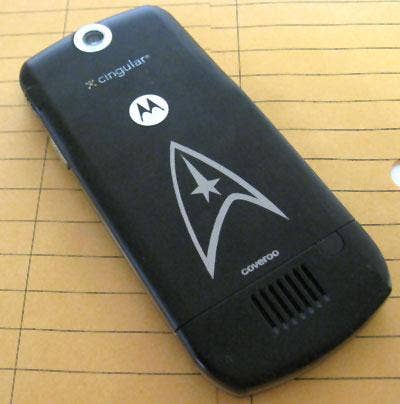
In an age where the emphasis is on personal electronics, Coveroo is on a mission to really personalize them.
The company demonstrated a laser etching device that adds personalization to an otherwise me-too mobile phone with logos, cartoons or brands that users choose themselves.
Karl Jacob, CEO and founder of San Francisco-based Coveroo, told the audience it's time to put the "personal" in personal electronics.
Coveroo offers a service under which a cell phone user can go to Coveroo's Web site, choose his or her cell phone type from one of 75 different models, choose a piece of artwork from hundreds of options and purchase a new back cover.
Coveroo then uses its high-powered, 1,200-dpi laser to etch the art directly onto a new back cover matching the customer's model, and sends the cover to the customer.
The etching does not rub off, collect dirt, or get ink on one's hands, Jacob said. Customers can choose colors such as stainless steel, gold, and even glow-in-the-dark.
At DEMO, Coveroo made available new art, such as illustrations featuring Garfield and Resident Evil 5. The company also said its technology now works with iPhones, and in the future will be extended to laptops, notebooks and MP3 players.
Pricing for the etched covers ranges from $9.95 to $59.95.
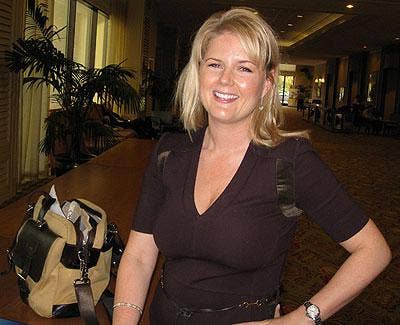
Qualcomm MEMS Technologies is looking to cut the amount of power consumed by the biggest power drain in mobile devices, the display, with a new technology.
That technology, micro-electro-mechanical systems, or MEMS, incorporates a micro-machine for each pixel in a monochrome display, or one for each sub-pixel in a color display, said Cheryl Schwartzman, director of marketing for the San Diego-based company.
Each pixel or sub-pixel has two conductive plates separated by air. One is a thin film stack on a glass substrate, and the other is a reflective membrane. When no voltage is applied, the plates are separated, and light hitting the substrate is reflected. When a small voltage is applied, the plates are pulled together by electrostatic attraction and the light is absorbed, turning the element black.
Schwartzman said there are two primary benefits to using MEMS in displays.
First, she said, a mobile device display using MEMS consumes about 1 mW (milliwatt) of power compared to the average of 220 mW consumed by an LED screen, leaving more energy for the handset.
Second, Schwartzman said, because MEMS uses reflected ambient light to display color, the outdoor viewability is much better than that of LEDs. "You're not fighting the sun," she said. "The sun is your friend."
MEMS-based displays are currently used in a few handsets in other countries, including Korea. However, Schwartzman said, the technology is commercially available only in monochrome. The U.S. market, she said, requires color displays, which are not yet ready.